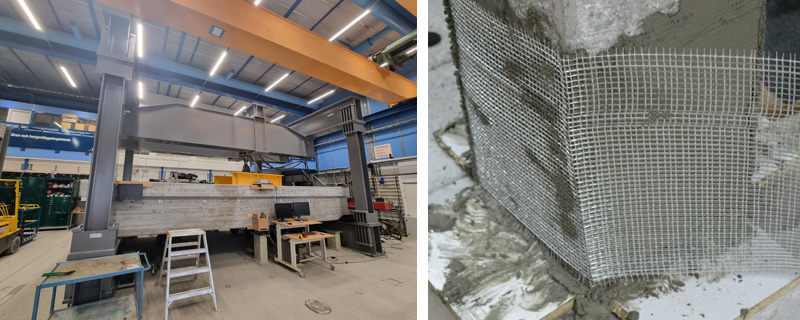© Luleå University of Technology and the Application of FRCM: © University of Nottingham
Researchers from the University of Nottingham are collaborating with Luleå University of Technology in Sweden for the first time, on a project that aims to improve the resilience of the world’s bridges – making them safer and more sustainable as traffic levels rise.
The recent 26-month closure of Hammersmith Bridge due to concerns about cracking in the infrastructure, as well as the ongoing RAAC concrete crisis demonstrate that much of the UK’s current infrastructure is nearing, or has exceeded, its expected design life. With temperatures soaring due to climate change, and traffic levels gradually rising again post-pandemic, the speed of this deterioration is only increasing.
When it comes to bridges, it’s not economically or environmentally possible to simply replace them, meaning the only viable solution is to repair and strengthen them. In the UK alone, the cost of repairing bridges due to corrosion damage is estimated to cost millions of pounds.
Non-corrosive Fibre-Reinforced Polymer (FRP) composites are excellent strengthening systems for corrosion-damaged concrete structures, but they come with their own drawbacks, such as high price, high environmental impact due to resin use, and poor fire resistance. As a result, a new generation of composites has been developed – Fibre-Reinforced Cementitious Mortar (FRCM). FRCMs are compatible with concrete, breathable, resistant to fire, applicable on wet surfaces, sustainable, reversible, low carbon, and cost-effective – being at least 30% cheaper than FRPs.
The main goal of the Climate Adaptation for REsilient Bridges (CARE) project is to find durable and sustainable solutions by investigating how different temperatures and accumulated damage caused by repeated load cycles affect the performance of FRCM composites when used in bridge strengthening.
Dr Georgia Thermou, Assistant Professor in Structural Engineering at the University of Nottingham, said:
“Although experimental evidence has demonstrated the efficiency of FRCMs when it comes to improving undamaged structures, it has not been tested on more complex structural systems with accumulated damage or that have been subject to seasonal temperature changes.
“Our experiments and simulations will generate new knowledge, which will benefit the construction and composites industries by providing a sustainable solution for strengthening bridges and creating a new market for composites respectively. Additionally, it will greatly benefit society by providing safe and sustainable infrastructure that will contribute towards a greener economy and, crucially, minimise bridge closures or even failures.”
The CARE project has been funded by the Royal Society as part of its International Exchanges scheme, which allows scientists across the UK to collaborate with leading institutions overseas.
Professor Gabriel Sas, Head of Subject at Department of Civil, Environmental and Natural Resources Engineering at Luleå University of Technology, said:
“Collaboration across borders is essential for tackling the global challenges we face in infrastructure and sustainability. This partnership with the University of Nottingham allows us to combine our expertise in structural engineering and material science to develop innovative solutions for bridge resilience.”
Dr Jaime Gonzalez-Libreros, Associate Senior Lecturer at Luleå University of Technology, who will be collaborating closely with Prof. Sas and Dr. Thermou in the project, added:
“Our aim is not just to extend the lifespan of existing structures but to do so in a way that is economically viable and environmentally responsible. This project is a step forward in creating a sustainable future for our communities.”
Dr Thermou added:
“Being able to establish connections and collaborate with other leading universities across the world is crucial when it comes to sharing knowledge and finding solutions that multiple countries can benefit from, so I’m looking forward to working with Professor Sas and his research group to see what we can learn together over the next two years. I would also like to acknowledge Royal Society for supporting this effort and enabling the project to take place.”





Leave a Reply
Want to join the discussion?Feel free to contribute!